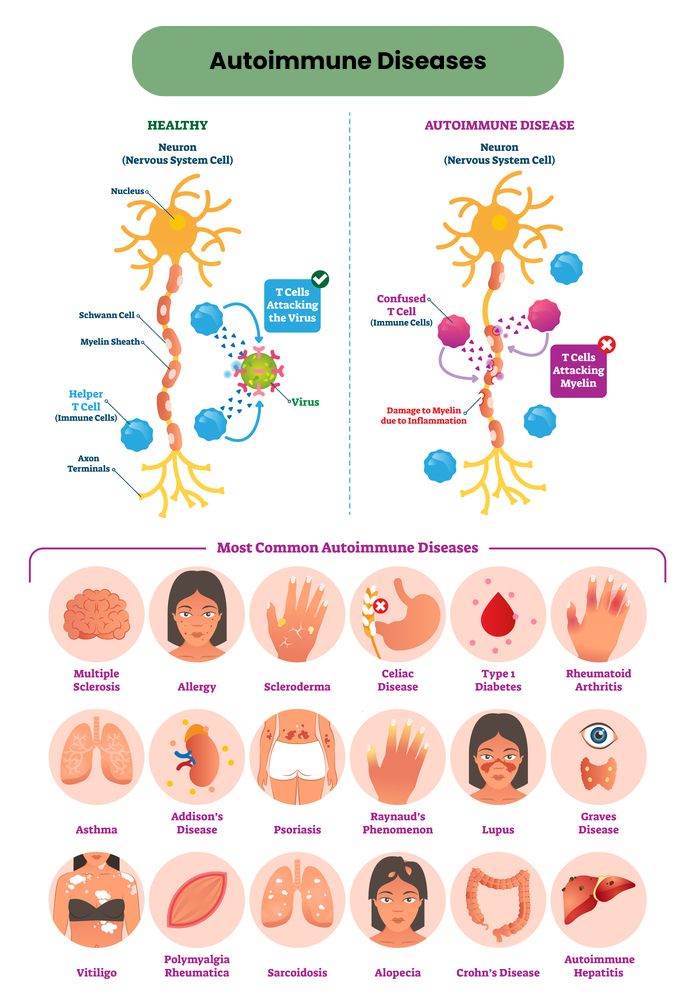Autoimmune Diseases

Our body has an efficient and sophisticated mechanism to protect us from diseases and disease-causing microbes like bacteria, viruses, fungus etc. This system is called immune system. Our immune system has an army of specialised cells which attack and kill the disease-causing microbes and can very well differentiate between our body cells from the disease-causing microorganism.
In auto immune diseases, unfortunately our immune system forgets to differentiate between our body cells and tissues from disease causing microbes and attacks our own body cells, tissues or organs resulting in tissue damage, inflammations and various diseases. Almost any tissue or organ can be affected by auto immunity.
Auto immune disease remains among the most poorly understood, under reported and under diagnosed of any category of diseases. Their signs and symptoms are highly variable and vague making it difficult to suspect or diagnose auto immune diseases. There are more than 100 auto immune diseases but leading research in the field suspects at least 40 additional diseases will be having an auto immune response.
There is no single test to diagnose auto immune diseases. A collection of symptoms combined with specific blood markers and in some cases even a biopsy may be needed to diagnose it. It is always multi factorial. So, this results in long delays in diagnosis and starting an effective treatment. Most immune patients see three or more doctors over three years before a right diagnosis. Another interesting factor in auto immune disease is that women are more affected than men. Nearly 75% of auto immune disease patients will be women. And the women affected are mostly younger women in their healthy childbearing years.
Over 45% of auto immune disease patients are labelled as “chronic complainers “in early stages of their illness.
The early symptoms of many auto immune diseases are as following
- Fatigue
- Pain in the joints, muscles, fascia etc
- Swelling and redness in the body
- Low grade fever
- Memory loss or in ability to concentrate [brain fog]
- Numbness and /or tingling sensations in the hands and feet
- Hair loss, dry eyes etc.
- Skin rashes and allergic reactions
One thing all these diseases have in common is inflammation, which can lead to pain, swelling and other complications. This inflammation can be seen anywhere in the body in any organ or tissue.
Auto immune diseases are rising in recent times for reasons unknown likewise the causes of the diseases remain a mystery.

Examples of auto immune diseases include Rheumatoid arthritis, Systemic Lupus Erythematosus (SLE), Inflammatory Bowel Disease(IBD), Multiple sclerosis (MS),Type1 Diabetes Mellitus, Psoriasis, Hashimoto’s Thyroiditis , Vasculitis etc.
Because many of these auto immune diseases are chronic and lifelong with high morbidity, they can be devastating to the patients and their families and very costly from a public health perspective. Based on current rising trends in Prevalence, they are going to be one of the major health care cost drivers in the near future.
Three factors are at play in the pathogenesis of autoimmune diseases: genes, immune system, and the environment where the patient lives. The genes confer what is called “predisposition” or genetic susceptibility. The immune system gets dysregulated and provides the tools for executing the pathological damage. The environment deliver the triggers that may make the autoimmune disease clinically apparent.
A recent study at baker heart and diabetes Institute, Australia, suggests that the secret to autoimmune diseases may lie in the way various genes express in our childhood and the variations in these genes may be what predispose a person to developing auto immune disease after in life.
As the gut is a major site of complex interactions which control immunity, it is the largest interface between an individual and his environment, and therefore, provides the largest exposure for immune building micro-organisms and exposure to toxins and allergens.
